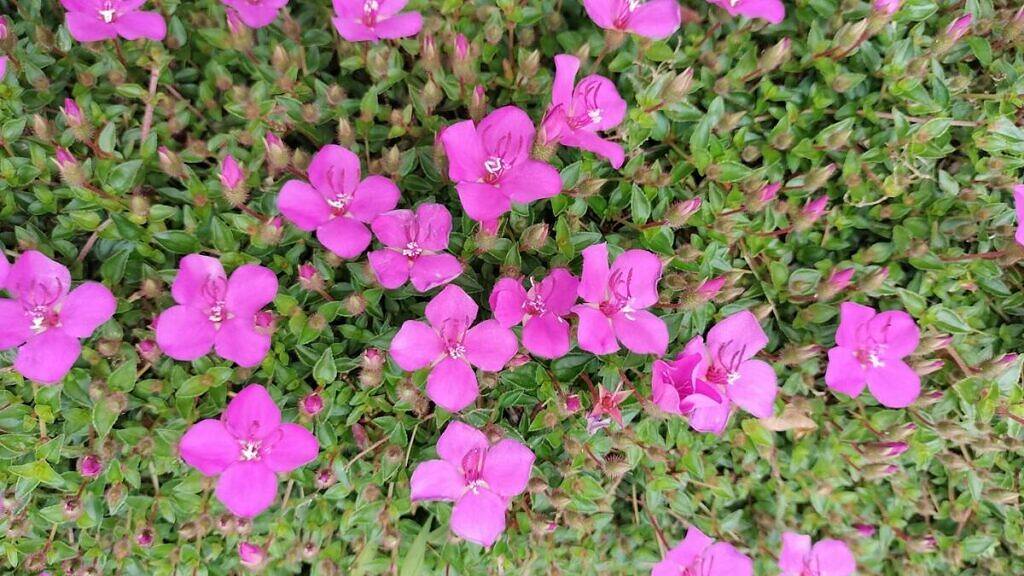The Spanish Shawl (Heterocentron elegans) is a perennial, low-growing herbaceous plant from the Melastomataceae family, cultivated as an ornamental ground cover for its almost continuous magenta blooming and its green-coppery foliage, which is reddish underneath. Recommended for carpeting garden beds in full sun or partial shade, it also adapts well to containers and planter boxes, where its branches cascade, and on slopes, where it forms dense mats. It is also known as the groundcover princess flower or ‘esquizocentro’, and in the literature it is frequently listed under its former name Schizocentron elegans. In gardens with tropical and subtropical climates, it performs well and is highly attractive to bees.
The genus name Heterocentron combines the Greek roots hetero (different) and kéntron/centron (spur, tip), while the species epithet ‘elegans’ comes from Latin, meaning ‘elegant’. This species displays the typical traits of the Melastomataceae family, such as the shape and pattern of its flowers and leaves—similar to the Purple Glory Tree (Pleroma granulosum)—which has earned it the common name trailing princess flower. Internationally, it is widely sold as Spanish Shawl, trailing princess flower, or trailing lasiandra, reflecting its botanical kinship with princess flowers of the genus Pleroma.
Spanish Shawl is native to Mexico, Guatemala, Honduras, and El Salvador, thriving in tropical to subtropical climates across Mesoamerica. Its natural habitat includes bright environments, tolerating anything from full sun to partial shade in warm locations, and it is not frost-hardy. Under these conditions, it blooms year-round, with more abundant flowers in the warmer months. In areas with filtered shade, such as beneath a tree canopy, flowering may decrease, although it still maintains attractive, dense foliage.

Heterocentron elegans is a perennial herbaceous plant with a creeping to decumbent growth habit, often with a semi-woody base in mature specimens. Spanish Shawl has a low profile, typically reaching 4–12 inches (10–30 cm) in height, spreading laterally in dense mats as its stems root along the ground. The root system of the Spanish Shawl is predominantly taproot, a characteristic feature among dicotyledons, complemented by numerous adventitious roots that form at the nodes of prostrate stems. This configuration provides shallow anchoring and highly effective ground cover.
The stems are slender, cylindrical, ranging in color from green to wine-red, with a smooth, tender epidermis, and a diameter of only a few millimeters. These branches root easily upon contact with potting mix (substrate). Spanish Shawl exhibits rapid growth in warm and humid conditions, producing profuse branching and short internodes at the apical portions, which reinforces its suitability as ground cover.
Leaves are simple, opposite, and decussate, with blades that are ovate to elliptical, margins that are entire to slightly serrated, and tips that are acute to subtly acuminate. Typically, leaves measure about 0.8–2.4 inches (2–6 cm) long by 0.4–1.2 inches (1–3 cm) wide, supported by short petioles. The upper (adaxial) surface is green, often with a coppery hue, while the lower (abaxial) side is reddish to wine-colored. The veins display an acrodromous pattern, with 3–5 primary veins emerging close to the leaf base, and are especially prominent on the underside—this is typical of the Melastomataceae family. The texture ranges from papery (chartaceous) to slightly leathery (subcoriaceous), with a predominantly glabrous and subtly glossy surface. Spanish Shawl is evergreen in tropical and subtropical regions, maintaining its foliage year-round.

Spanish Shawl is a monoecious plant, presenting hermaphroditic flowers arranged in terminal cymose or racemose inflorescences. Blooming occurs throughout the year, with peak flowering during spring, summer, and fall in favorable climates. The inflorescences appear as axillary and terminal cymes with few flowers, concentrated in the distal third of the branches, accompanied by small bracts. Flowers are actinomorphic, usually with four broad, obovate petals in magenta to purple-violet hues, and are unscented; the stamens are prominent and typical of the family, attracting pollinators.
Pollination of the Spanish Shawl is primarily melittophilous, performed by bees seeking pollen. The fruit is a small, dry, dehiscent capsule, turning brownish when mature. Seeds are extremely numerous, tiny, and angular to irregular in shape, dispersed mainly by gravity and rainwater, facilitating the colonization of areas near the parent plant.
In landscaping, Spanish Shawl is used as a low-growing groundcover to create mass plantings and borders in areas ranging from full sun to partial shade. On gentle slopes and embankments, it acts as a spreading groundcover, following the terrain and quickly covering the soil. In residential gardens, Spanish Shawl works best as a continuous filler, creating a colorful “carpet” effect that ties together flowerbeds and pathways, providing contrast with medium-sized species. It pairs well with shrubby melastomes (e.g., Tibouchina spp.) and with groundcovers in cool, yellow, or silvery tones, complementing and contrasting with its magenta flowers.

In pots, window boxes, and hanging baskets, Spanish Shawl produces long stems that cascade naturally, forming showy floral waterfalls on sunny balconies. It’s an effective choice for softening low walls, terraces, and the edges of outdoor stairs, provided it receives ample sunlight and regular watering, especially during the warmer months when daily irrigation keeps the foliage vigorous. Due to its need for high light and more frequent watering cycles, Spanish Shawl is not recommended as a long-term indoor plant. Its function is more about mass planting and filling space than serving as an isolated focal point. In wildlife-friendly gardens, Spanish Shawl stands out for attracting bees, enriching the mosaic of pollinators throughout the seasons.
Spanish Shawl prefers full sun to partial shade, with stronger blooming in high light conditions; under filtered light, such as beneath tree canopies, it maintains dense foliage but produces fewer flowers. The ideal temperature range is 64–82°F (18–28°C); above 90–93°F (32–34°C), growth and flowering tend to decline, requiring more rigorous watering management. It does not tolerate frost or prolonged cold and may suffer damage below 41–44°F (5–7°C). Spanish Shawl should be protected from hot, dry winds and is not suitable for coastal areas due to its low salt tolerance.
In the garden, Spanish Shawl performs best in loam or sandy loam rich in organic matter, well-drained, and slightly acidic (pH 5.5–6.5). For containers, use a well-aerated potting mix, such as peat or coconut fiber blended with perlite/coarse sand and a stable organic component (compost or well-composted pine bark), always ensuring efficient drainage at the base.
Keep the potting mix evenly moist, without waterlogging; Spanish Shawl is sensitive both to prolonged drought and to excess moisture around the roots. During hot periods, daily watering might be necessary; in milder climates, 2 to 3 waterings per week are usually sufficient, adjusted based on local evapotranspiration. Prioritize high-quality water with low salinity and minimal carbonate content.

Plant Spanish Shawl seedlings in holes amended with organic compost, placing the root ball at soil level and spacing 10–14 inches (25–35 cm) between plants to ensure uniform coverage. Apply a mulch layer of 1–2 inches (3–5 cm) to retain moisture, stabilize soil temperature, and suppress competing weeds. Fertilize in spring and summer using well-aged organic matter and/or a balanced slow-release fertilizer (such as 10-10-10 NPK) every 2–3 months (60–90 days), avoiding over-fertilization.
On slopes and in hanging baskets, train and secure the trailing stems as they grow. Prune regularly to remove dry branches and lightly pinch back after flowering to encourage denser growth and vigorous regrowth; renew or divide sections of the groundcover every 2–3 years if needed.
Spanish Shawl has low incidence of pests and diseases; occasionally, green aphids may attack, especially on new shoots. Manage them with targeted water jets and neem oil or potassium soap, repeating as needed. In very dry conditions, monitor for scale insects and spider mites; adjust irrigation and improve ventilation to lower pest pressure. Avoid waterlogging to prevent root rot; maintain good drainage and water carefully. Young plants may be subject to herbivory by slugs and snails, which can be controlled with physical barriers or targeted baits.
Spanish Shawl is most efficiently propagated by separating prostrate stems that have already rooted: cut rooted segments with clean scissors, keeping a small soil ball attached, and replant in their final location or in containers. For large-scale propagation, use semi-hardwood tip cuttings (3–5 inches / 8–12 cm), remove the lower leaves, and plant about one third of the segment in a light, sterile potting mix (peat + perlite), under diffuse light and high humidity; rooting occurs in 3–5 weeks at 72–79°F (22–26°C). The best period is spring and summer, although in regions with mild climates it can be done year-round under controlled conditions.
Sowing is rarely used for ornamental cultivation. Well-rooted Spanish Shawl cuttings, provided with ample light and proper watering, typically begin flowering 2–4 months (approximately 8–16 weeks) after rooting, and remain in bloom for extended periods throughout the year.



